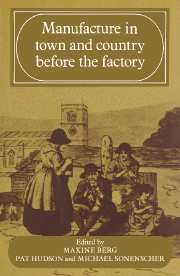Book contents
- Frontmatter
- Contents
- List of illustrations
- Acknowledgements
- 1 Manufacture in town and country before the factory
- 2 Political economy and the principles of manufacture 1700–1800
- PART I THE STRUCTURE OF MANUFACTURE
- PART II ‘WORK’ AND ‘WAGES’
- Appendix 1 Norwich embezzlement convictions in the eighteenth century: problems of evidence
- Appendix 2 Estimates of the size of the supplement to wages available through embezzlement in two eighteenth-century industries
- Appendix 3 Statutes concerned with embezzlement in the putting-out industries, 1500–1800
- Index
Appendix 1 - Norwich embezzlement convictions in the eighteenth century: problems of evidence
Published online by Cambridge University Press: 16 October 2009
- Frontmatter
- Contents
- List of illustrations
- Acknowledgements
- 1 Manufacture in town and country before the factory
- 2 Political economy and the principles of manufacture 1700–1800
- PART I THE STRUCTURE OF MANUFACTURE
- PART II ‘WORK’ AND ‘WAGES’
- Appendix 1 Norwich embezzlement convictions in the eighteenth century: problems of evidence
- Appendix 2 Estimates of the size of the supplement to wages available through embezzlement in two eighteenth-century industries
- Appendix 3 Statutes concerned with embezzlement in the putting-out industries, 1500–1800
- Index
Summary
Magistrates making convictions under the post-1749 embezzlement Acts were required to return certificates of conviction to Quarter Sessions for filing. Unfortunately the survival of Quarter Sessions files for the city of Norwich for the second half of the eighteenth century is incomplete. So is the survival of certificates within those files which do still exist. Some records of convictions were entered in the Norwich City Quarter Sessions Minute Books, but these too are deficient. By far the most complete available record of convictions for the city is provided by the continuous run of the Norwich Mercury, which regularly reported convictions in its local news column. All the data on Norwich convictions used in this essay are from the Norwich Mercury.
Although the manufacturers who undertook prosecutions tried to publicise convictions systematically in the press, especially during prosecution campaigns, some convictions were not reported. In order to use those convictions reported in the newspaper as a guide to the character and incidence of all convictions it is therefore necessary to establish by precisely how much they are deficient. It is possible to establish an approximate figure for this deficiency by comparing the convictions reported in the newspaper with those available from the city Quarter Sessions records. Between 1750 and 1779, 134 convictions for embezzlement and receiving were recorded in the Norwich Mercury and 76 in the Quarter Sessions records. Of that 76, 16% were not reported in the newspaper.
Assuming that this figure is indicative of the overall deficiency in the newspaper reporting of convictions, it does not pose a major obstacle to the use of the newspaper reports in aggregate as a guide to the character of convictions.
- Type
- Chapter
- Information
- Publisher: Cambridge University PressPrint publication year: 1983



